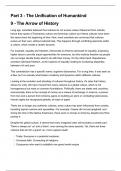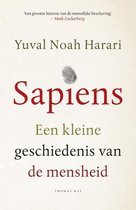Part 3 - The Unification of Humankind
9 - The Arrow of History
Long ago, scientists believed that cultures do not evolve unless influenced from outside,
hence they spoke of Tasmanian culture and American culture as if these cultures have been
the same since the beginning of time. Now, most scientists are convinced that cultures
evolve on their own, without external help. This happens through conflicting elements within
a culture, which create a certain dynamic.
For example, equality and freedom. Democrats in America advocate for equality, proposing
higher taxes to provide equal opportunities for everyone, but this restricts freedom as people
can no longer decide freely what to do with their money. On the other hand, Republicans
prioritize individual freedom, at the expense of equality, leading to increasing disparities
between rich and poor.
This contradiction has a specific name: cognitive dissonance. For a long time, it was seen as
a flaw, but it is actually what fosters creativity and dynamics within different cultures.
Looking at the evolution and blending of cultures throughout history, it's clear that history
strives for unity. We have moved from many cultures to a global culture, which is not
homogeneous but rests on common foundations. Politically, there are states and countries;
economically, there is the concept of money as a means of exchange; in science, a person
from Iran and a person from America agree on building an atom or combating tuberculosis.
Human rights are recognized globally, at least on paper.
There are no longer any authentic cultures; every culture has been influenced from outside,
including typical customs and specialties. For example, Caesar did not eat spaghetti, and
during the time of the Native Americans, there were no horses in America, despite how films
portray it.
Despite this global culture, it seems that every imagined order still excludes a certain part.
There is always an 'us' and a 'them', even among the same species. Yet, there are three
cultures that aim for a grand 'us', homo sapiens itself:
1. Trade: Everyone is a potential customer.
2. Universal faith: Connecting all religions.
3. Conquerors who want to establish one grand world empire
, 10 - The Scent of Money
In hunter-gatherer societies and early agricultural communities, economies were mainly self-
sufficient. People exchanged goods and services within small villages and between
individuals through barter. If someone excelled in a particular service, they could use it to
trade with others.
As cities grew larger, there were more products and services available. A person wanting to
trade had to carefully consider if the trade was fair, as keeping track of all products became
too difficult. This led to the emergence of money.
Money is an object with an imaginary value, a universal medium of exchange trusted and
believed in by everyone. Money has several advantages: firstly, you can use it for anything
you want; you are not restricted to trading apples for shoes, as you can use money to buy
barley, even if the person with the shoes doesn’t have barley. You can also store money;
many things must be used or take up a lot of space when stored, but money can be kept in a
safe or a wallet. Money doesn't necessarily have to be what we know it as now; different
communities used it however they wanted, such as rolls of cloth or shells.
Money has no value; why would we want it? We want it because there is collective
confidence in it; everyone believes and trusts that if they have money, they can use it to buy
something else, and the other will agree. The value of money is fixed and everyone uses it.
The first money was found among the Sumerians. They set a certain amount of barley to
buy things, but this was hard to move and store. You need something else. For example,
many societies used silver; a certain amount of silver equaled an apple, and two apples, so
double that amount. But such a silver clump didn't necessarily have to be regular in shape; it
just had to weigh a certain amount. And how did the person who received the silver know for
sure that it wasn't a clump of lead with a silver coating?
Societies began to strike coins, with two tokens, the exact amount of silver, and a king's
token. This makes everyone trust it because counterfeit money is considered one of the
biggest crimes.
In place of silver, China developed a gold system, which is now seen as a valuable object
worldwide, even though you cannot wear or eat it. How did this happen? Well, this is a fine
example of supply and demand. Here's an example: Suppose gold in place A has very little
value and is not used, while everyone wants gold in place B because it has high value.
Traders will notice this and buy a lot of gold in place A and sell it in place B. The more people
who do this, the more demand for gold in place A, where the price of gold will rise, and the
more gold there is in place B, where the price will drop. Soon, the value of gold in both
places will be the same.
Money rests on two pillars: first, collective confidence, and second, the trust that you can
use it everywhere. However, money also has a dark side. Trust in money does not equate to





